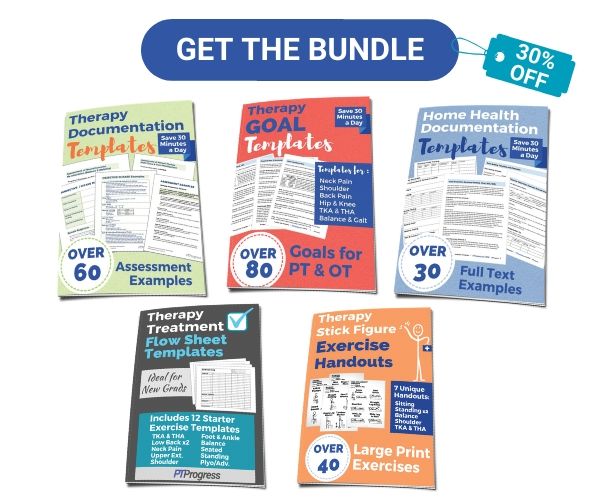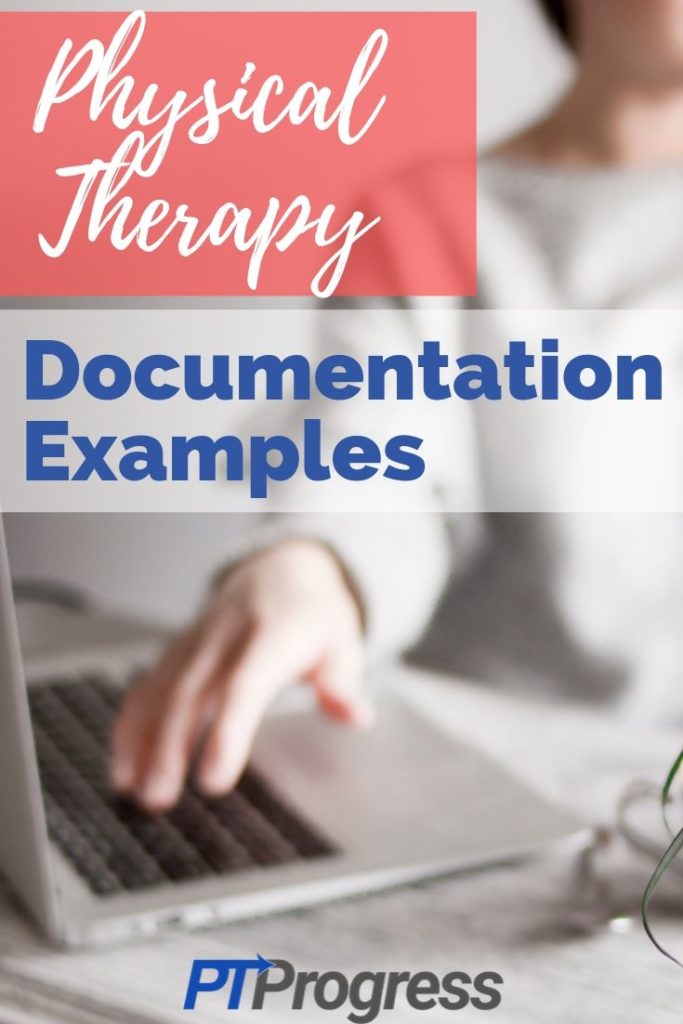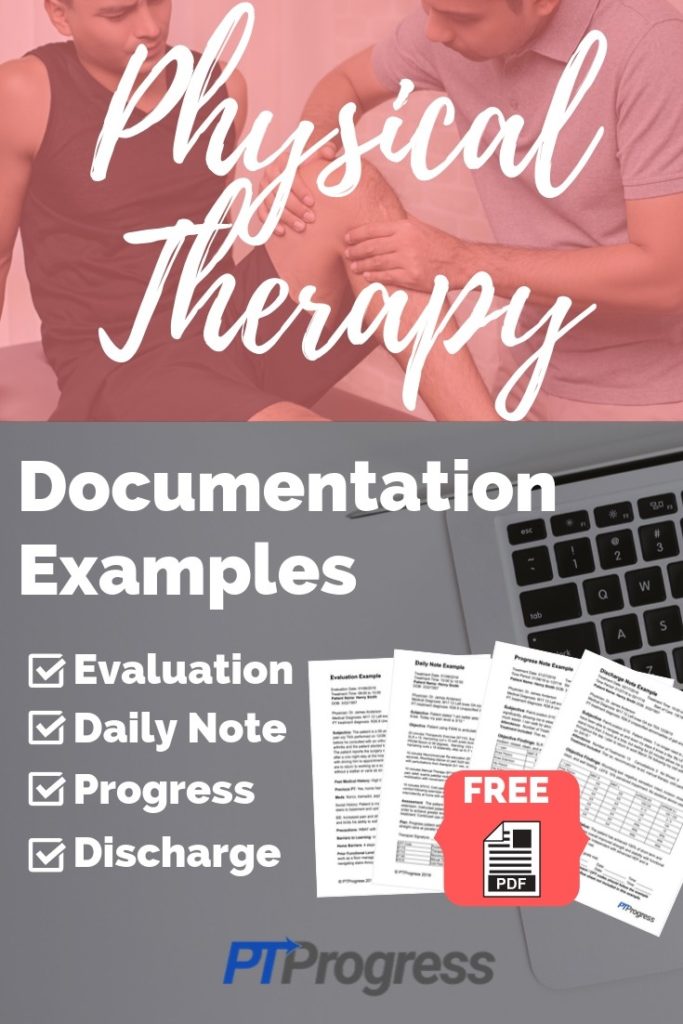Physical therapy documentation is an important tool for recording therapy treatments and tracking a patient’s progress. It can also be the cause of major headaches, rushed lunch hours, and excessive typing throughout the day.
Students and therapists alike have experienced difficulty locating helpful physical therapy documentation examples. I know because I, too, looked in vain for defensible documentation examples online.
Fast forward 6 years, and I’ve written thousands of physical therapy soap notes and helped hundreds of therapists with documentation examples and strategies on this blog.
Physical Therapy Documentation Examples
You may not have the time to read dozens of documentation examples, so I have included below an example of 4 types of notes commonly used in physical therapy.
These examples will give you an idea of how you might perform a patient’s documentation. Although they are written for a sample patient in an outpatient setting, you can use similar wording for the subjective, objective, and assessment goals in other settings (such as neuro, home health, skilled nursing, or acute rehab).
You can download these examples in PDF format here (click on image).
Physical Therapy Evaluation Example
Evaluation Date: 01/06/2016
Treatment Time: 09:00 to 10:00
Patient Name: Henry Smith
DOB: 3/22/1957
Physician: Dr. James Anderson
Medical Diagnosis: M17.12 Left knee OA s/p TKA 12/28/15
PT treatment diagnosis: R26.9 Unspecified abnormalities of gait and mobility
Subjective
The patient is a 59-year-old male who presents with left knee pain s/p TKA performed on 12/28/15. The patient reports having knee pain for years before he consulted with an ortho surgeon in August of 2015. An X-ray revealed severe arthritis and the patient elected to undergo total knee replacement in December of 2015. The patient reports the surgery was performed with no issues. He was released home after a one-night stay at the hospital. The patient lives with family who are able to assist driving him to appointments until cleared by a physician to drive. The patient’s goals are to return to work as a supervisor at the local car manufacturer, and to “walk without a walker or cane as soon as possible.”
Past Medical History: High blood pressure
Previous PT: Yes, home health 4 days after surgery
Meds: Norco, tramadol, aspirin, lisinopril
Social History: Patient is married and lives in a 2-story home with 4 steps to enter and 13 stairs to the basement and upstairs. Master bedroom/bathroom is on the main floor.
CC: Increased pain and stiffness in left knee prevents him from sleeping well at night and limits his ability to walk or stand for more than 10 minutes.
Precautions: WBAT with FWW, progressing to cane as tolerated
Barriers to Learning: none
Home Barriers: 4 steps to enter home
Prior Functional Level: Patient was independent in all areas. Patient is active in his work as a floor manager at a local car manufacturer and could stand 8 to 10 hours a day, navigating stairs throughout the facility.
Objective
Cognition: AOx3
Vital Signs: BP 122/88, HR 76, RR: 16
Posture: Patient stands with forward flexed trunk position using walker and demonstrates a favoring of the left knee in keeping it flexed.
Pain Scale / location / behavior: Patient presents with pain along the left joint line lateral to the left patella. Patient denies tenderness behind the knee and along the incision. Pain increases with knee flexion, described as “tightness” due to increased swelling. Patient rates pain at 4/10 at present, 3/10 at best and 6/10 at worst. Patient reports decreased sensation along the incision line; sensation is intact otherwise.
Integumentary: Surgical incision noted along midline of left knee. Steri strips are present along a 20 cm incision. Skin appears dark pink, dry and well healing. No open areas noted. Mild to moderate edema noted at knee with pitting noted as 1+ at tibia. No signs of infection noted.
Lower Extremity Functional Outcome Score: 55% disability score
ROM / Strength
| * = pain | MMT R | MMT L | A/PROM (R) | A/PROM (L) |
| Knee Flexion | 5/5 | 4/5 | 125/125 | 75 / 80 * |
| Knee Extension | 5/5 | 3+/5 | 0 / 0 | -5 / – 3 * |
| Hip Flexion | 5/5 | 4/5 | 120 | 120 |
| Hip Extension | 5/5 | 4/5 | 10 | 10 |
| Hip Abduction | 5/5 | 4/5 | WNL | WNL |
| Ankle Dorsifl. | 5/5 | 5/5 | WNL | WNL |
| Ankle Plantar. | 5/5 | 4/5 | WNL | WNL |
Gait: Patient ambulates on level surfaces with FWW. He demonstrates gait deviations that include the following: increased lateral trunk lean to the left with stance phase, decreased push off bilaterally, poor knee flexion with swing, decreased hip extension with push off and impaired ability to turn corners due to unsteadiness attributed to unnatural use of walker. Advised patient on safe use of walker to encourage proximity to device.
Balance: Rhomberg stance: positive; Single-leg stance: unable on Left, for up to 3 seconds on Right. Tandem stance: requires UE support with balance loss upon perturbation.
Reflexes: DTR intact at ankle; not tested at knee due to incision at knee.
Extensibility: Tightness noted in the following muscle groups: bilateral hamstring, quadriceps, and gastroc/soleus.
Special Tests: PDVT Screen: negative.
Treatment Provided: Total knee protocol to include instruction of HEP and performance of the following exercises: ankle pumps x 20, quad sets x 15, SLR x 10, sidelying SLR x 10, glute squeezes x 20, mini squats x 10, heel slides x 15. Cold pack x 10 minutes in supine following ther ex.
Physical Therapy Assessment
Problem Summary: Increased pain at left knee, decreased ROM of left knee, decreased strength of L LE, balance deficits in standing, difficulty with weight bearing activities, altered posture, lack of home exercise program, impaired gait form and use of assistive device.
Assessment Statement: Patient presents with signs and symptoms consistent with diagnosis of L knee OA, s/p 1 week post operative L TKA. Rehab potential is excellent. Key impairments include: decreased ROM and strength of the left lower extremity, poor balance and compensatory gait patterning, increased swelling, and pain with functional activities such as squatting, walking, and stairs. A skilled PT is required to address these key impairments and to provide and progress with an appropriate home exercise program. This evaluation is of moderate complexity due to the changing nature of the patient’s presentation as well as the comorbidities and medical factors included in this evaluation.
Goals
Short Term Goals
Within 2 weeks, the patient will achieve 90˚ knee flexion consistently in order to progress with functional activities such as rising from a chair with equal weight bearing.
Within 2 weeks, the patient will demonstrate improved quad strength and motor control as noted by ability to perform SLR without lag in order to progress into advanced ther ex.
Within 2 weeks, the patient will report a 20% reduction in knee pain at night in order to facilitate their ability to fall asleep.
Long Term Goals
Within 4 weeks, the patient will demonstrate independent ambulation on level surfaces without a straight cane in order to safely navigate the community without gait compensation.
Within 5 weeks, the patient will demonstrate an increase in quadriceps strength by 1 MMT grade to ascend and descend stairs without the knee buckling.
Within 6 weeks, the patient will demonstrate increased knee flexion AROM to 120 in order to improve the patient’s ability to descend 2 flights of stairs at work.
Within 6 weeks, the patient will report the ability to walk for 45 minutes without knee pain in order to perform work tasks such as navigating the plant facility.
Plan
Patient will be seen by a PT and/or PTA 2x per week for 6 weeks under the diagnosis of Left knee OA s/p L TKA and will be reassessed every 7-10 visits for progress.
Treatment to Include: AROM/AAROM/PROM, balance and proprioception training, strengthening exercises, HEP, mobilization, posture/body mechanic training, neuromuscular re-education, and ice pack to LLE.
Certification period: 1/6/16 – 2/24/16
The patient has been educated in the evaluation findings, prognosis, and plan of care, and is in agreement and willing to participate in therapy.
Thank you for this referral and please call xxx-xxx-xxxx with any questions or concerns.
Physical Therapist: _______________________ Date:_________ Time: _________
Physician Signature: ______________________ Date: ________ Time: _________
Billing
| CPT Code | Procedure | Unit / Time |
| 97162 | PT Evaluation (Moderate) | 1 / 25 minutes |
| 97110 | Therapeutic Exercise | 2 / 25 minutes |
| 97010 | Cold Pack (untimed) | 1 / 10 minutes |
| Total Treatment Time | 60 minutes | |
| Total Timed Minutes | 50 minutes |
Physical Therapy Daily Note Example
Treatment Date: 01/08/2016
Treatment Time: 10:00 to 10:50
Patient Name: Henry Smith
DOB: 3/22/1957
Physician: Dr. James Anderson
Medical Diagnosis: M17.12 Left knee OA s/p TKA 12/28/15
PT treatment diagnosis: R26.9 Unspecified abnormalities of gait and mobility
Subjective
Patient stated “I am better able to sleep at night with less throbbing in my knee. Today my pain level is 3/10.”
Objective
Patient used FWW to ambulate into clinic with equal step length noted.
20 minutes Therapeutic Exercise (97110): Supine exercises included: active quad sets x 15, SLR x 15, Hamstring curl x 10 with ankle dorsiflexion x 3 each rep, SAQ with bolster x 15. PROM flexion to 95 degrees. Standing: mini squats x 10, hip abduction x 10 bilaterally, hamstring curls x 15 bilaterally, step up to 3” step x 10 alternating LE.
10 minutes Neuromuscular Re-education (97112): Weight shifting on balance pad 3×20 seconds, Rhomberg stance on pad 3×20 seconds with one UE support, semi tandem stance with perturbations from therapist 2×1 min., rocker board for proprioceptive training x 3 min.
10 minutes Manual Therapy (97140): Seated tibiofemoral distraction grade 2 mobilization for pain relief, supine patellar mobilizations in superior/inferior direction: grade 2 x 4 minutes, mobilization with movement of patella with SAQ x 3 minutes.
10 minutes Cold Pack (97010): Left knee patient in supine with knee supported by bolster for comfort following exercises and treatment. Instructed patient to continue using ice intermittently at home with elevation throughout the day to minimize swelling.
Assessment
The patient demonstrates lack of quad muscle recruitment during knee extension. Instructed patient in co-contraction of quads to improve motor recruitment in order to achieve greater knee extension. Poor balance on an uneven surface noted during treatment. Continued use of FWW recommended.
Plan
Progress patient with strengthening exercises to increase quad activation and trial straight cane at parallel bars.
Therapist Signature: _________________ Date: _____________ Time: __________
| CPT Code | Procedure | Unit / Time |
| 97110 | Therapeutic Exercise | 1 / 20 minutes |
| 97112 | Neuromuscular Re-ed | 1 / 10 minutes |
| 97140 | Manual Therapy | 1 / 10 minutes |
| 97010 | Cold Pack | 1 / 10 minutes |
| Total Treatment Time | 50 minutes | |
| Total Timed Minutes | 40 minutes |
Progress Note Example
Treatment Date: 01/27/2016
Treatment Time: 10:00 to 11:00
Time Period: 01/06/16 to 1/27/16
Start of Care: 1/6/16
Patient Name: Henry Smith
DOB: 3/22/1957
Physician: Dr. James Anderson
Medical Diagnosis: M17.12 Left knee OA s/p TKA 12/28/15
PT treatment diagnosis: R26.9 Unspecified abnormalities of gait and mobility
Subjective
Pain/Location: 2/10; Patient states, “My knee pain has decreased significantly, allowing me to sleep through the night and to sit and stand from chairs much more easily. I can walk for about 20 minutes with the cane before I need to sit to rest.”
Attendance: Number of Treatments: 7; Cancellations: 0; No Shows: 0
Treatment Included: Ther ex, neuromuscular re-ed, manual therapy, cold pack, HEP
Objective Findings
SLR lag: 1 degree, Rhomberg test: negative; sensation: intact; incision: closed, clean, and healing well. Patient uses a straight cane for ambulation.
Treatment Provided
(Examples for treatment provided would follow a similar format as noted above in the Daily Note Example. You may also document treatment provided in a flow sheet. To shorten this example, the treatment has been omitted but would follow a similar format as the treatment listed in the Sample Daily Note.)
| * = pain | MMT R | MMT L | A/PROM (R) | A/PROM (L) |
| Knee Flexion | 5/5 | 4+/5 | 125/125 | 100 / 110 |
| Knee Extension | 5/5 | 4/5 | 0 / 0 | -2 / – 2 * |
| Hip Flexion | 5/5 | 4+/5 | 120 | 120 |
| Hip Extension | 5/5 | 4+/5 | 10 | 10 |
| Hip Abduction | 5/5 | 4+/5 | WNL | WNL |
| Ankle Dorsifl. | 5/5 | 5/5 | WNL | WNL |
| Ankle Plantar. | 5/5 | 4+/5 | WNL | WNL |
Assessment & Goal Status
The patient is progressing well towards goals established at evaluation, achieving 100% of short-term goals. Long-term goals will be addressed with further treatment. Patient lacks full strength to ascend full flight of stairs reciprocally and demonstrates impaired balance on dynamic surfaces.
Plan
☐ Discharge from PT x Continue PT 2 x per week for 3 weeks
To focus on quad strengthening, stair navigation, balance training, and gait training.
Therapist Signature: ______________ Date: ____________ Time: _________
Physician Signature: ______________ Date: ____________ Time: _________
Please sign and fax to: ____________
| CPT Code | Procedure | Unit / Time |
| 97110 | Therapeutic Exercise | 1 / 20 minutes |
| 97112 | Neuromuscular Re-ed | 1 / 20 minutes |
| 97140 | Manual Therapy | 1 / 10 minutes |
| 97010 | Cold Pack | 1 / 10 minutes |
| Total Treatment Time | 60 minutes | |
| Total Timed Minutes | 50 minutes |
Discharge Note Example
Treatment Date: 02/17/2016
Treatment Time: 10:00 to 10:50
Time Period: 01/27/16 to 02/17/16
Start of Care: 1/6/16
Patient Name: Henry Smith
DOB: 3/22/1957
Physician: Dr. James Anderson
Medical Diagnosis: M17.12 Left knee OA s/p TKA 12/28/15
PT treatment diagnosis: R26.9 Unspecified abnormalities of gait and mobility
Subjective
Pain/Location: 0/10; Patient states, “I no longer need to use the cane and have been able to navigate up and down my steps 8 times a day. My LE swells when I stand more than 3 hours at a time, but resting for 20 minutes allows me to stand throughout the day. I plan to return to work March 7th following my visit with the surgeon on 3/4/16.”
Attendance: Number of Treatments: 13; Cancellations: 0; No Shows: 0
Treatment Included: Ther ex, neuromuscular re-ed, manual therapy, cold pack, HEP
Objective Findings
Rhomberg test: negative; sensation: intact; incision: closed, clean, and healing well. LEFS: 10% perceived impairment. No assistive device used.
Treatment Provided
(Examples for treatment provided would follow a similar format as noted above in the Daily Note Example. You may also document treatment provided in a flow sheet. To shorten this example, the treatment has been omitted but would follow a similar format as the treatment listed in the Sample Daily Note.)
| * = pain | MMT R | MMT L | A/PROM (R) | A/PROM (L) |
| Knee Flexion | 5/5 | 5/5 | 125/125 | 120 / 120 |
| Knee Extension | 5/5 | 5/5 | 0 / 0 | 0 / 0 |
| Hip Flexion | 5/5 | 5/5 | 120 | 120 |
| Hip Extension | 5/5 | 5/5 | 10 | 10 |
| Hip Abduction | 5/5 | 5/5 | WNL | WNL |
| Ankle Dorsifl. | 5/5 | 5/5 | WNL | WNL |
| Ankle Plantar. | 5/5 | 5/5 | WNL | WNL |
Assessment & Goal Status
The patient has achieved 100% of short-term and long-term goals. He demonstrates overall improved strength and stability with functional activities and with gait form. Patient is independent with advanced HEP and is agreeable to discharge with all goals met.
Plan
x Discharge from PT with all goals met.
Therapist Signature: _____________ Date: ____________ Time: _________
Physician Signature: ______________ Date: ____________ Time: _________
| CPT Code | Procedure | Unit / Time |
| 97110 | Therapeutic Exercise | 1 / 15 minutes |
| 97112 | Neuromuscular Re-ed | 1 / 15 minutes |
| 97530 | Therapeutic Activity | 1 / 20 minutes |
| Total Treatment Time | 50 minutes | |
| Total Timed Minutes | 50 minutes |
Physical Therapy Documentation Phrases
Get in the habit of starting your sentences with action words that describe the patient’s ability to perform functional tasks.
Here are a few keywords to consider:
“The patient…
- performs, demonstrates, reaches, achieves/does not achieve, lacks, displays
“A functional movement…
- overhead lifting, reaching, pulling, gripping, squatting, lateral shifting, single-leg stance
“With an identified deficit or quality of performance…
- poorly, with decreased stability, with insufficient muscle recruitment, with unsafe control,
“Causing….
- poor foot clearance, improper hip alignment, impaired posture, increased stress, further irritation.
“Reason for Therapy to continue….” or “Key impairments to be addressed with further therapy in order to …
- to progress with stability training, to decrease the risk of falling, to safely manage lifting # items at home, to independently don/doff clothing, to perform head checks in vehicle safely, etc.”
It’s not enough to simply say, “The patient performed the exercises with good form.”
That doesn’t tell us anything, and it neglects to mention any cueing you provided. If you didn’t provide any cueing, recommendation, or therapeutic insight or intervention, what did you do??
Physical Therapy Assessment Documentation
Most of the difficulty in writing defensible documentation lies in the assessment section.
By the time you get to this section, you might feel as if you’ve used all your mental energy typing the preceding subjective and objective sections!
With my 60+ examples of assessment phrases in real-life scenarios, you’ll have access to a comprehensive resource that will improve the efficiency and quality of your writing. These Therapy Documentation Templates will help you effortlessly write physical therapy assessment phrases that are as skilled as the treatments you provide in the clinic.
You know you are providing your patients skilled treatment.
Make sure your documentation shows it – but in less time and with better clarity!
Download the Therapy Documentation Templates to save time in the clinic.
Because Physical Therapists deserve to go home to family, not paperwork.




